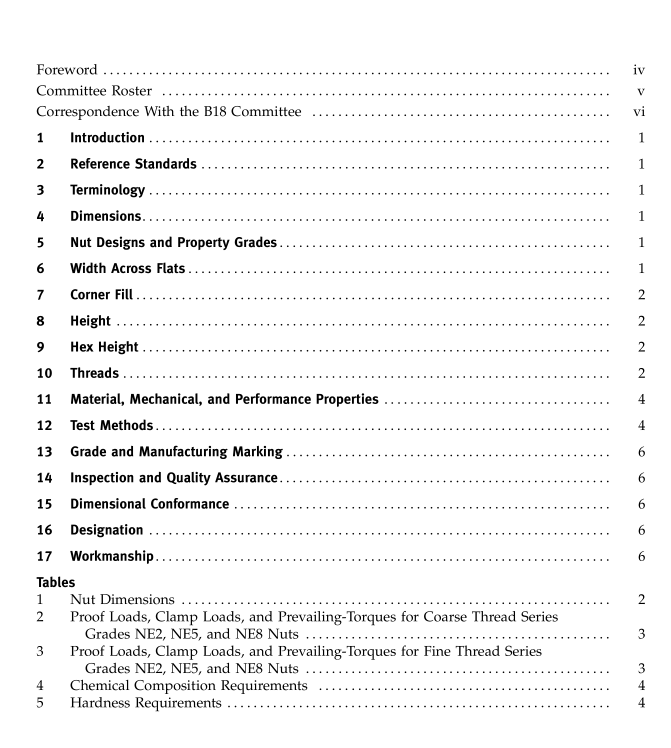ASME B18-16.6:2008 pdf download Nylon Insert Locknuts (Inch Series)
12.1.1 Test Bolt.The bolt used for proof load testinga nut shall have threads conforming to Class 2A toler-ances as specified in ASME B1.1.The test bolt shall havea yield strength in excess of the specified proof load ofthe nut being tested.
12.1.2 Hardened Mandrel. The hardened mandrelused for proof load testing a nut shall have threadsconforming to Class 3A folerances as specified inASME B1.1, except that the major diameter shall bethe minimum major diameter with a plus tolerance of0.002 in. The mandrel shall be heat treated to a hardnessof Rockwell C45 to C50.
12.2 Hardness Test
The Rockwell hardness of a sample nut shall be deter-mined on the top face of the nut. The top surface ofthe nut shall be prepared by grinding and removingsufficient material from the top to eliminate the effectsof plating, coating, or other surface conditions. Materialremoval shall also be such as to provide a flat area largeenough to allow a hardness test to be made midwaybetween the hex corner and the major diameter of thethread.The bearing surface of the nut shall be preparedparallel to the test surface with removal of plating orcoating.Further preparation of the test specimen andthe method of performing the test shali conform toASTM E 18.
For referee purposes, nut hardness shall be taken ona longitudinal section through the nut axis with readingstaken as close as possible to the nominal major diameterof the nut thread.
12.3 Prevailing-Torque Test
The prevailing-torque test shall be conducted at roomtemperature using a load measuring device (seepara.12.3.2).A test bolt (see para. 12.3.3) and/ or hard-ened mandrel (see para.12.1.2) shall be inserted in theload measuring device, and hardened washer (seepara. 12.3.4) placed on the bolt or mandrel and the sam-ple nut then assembled on the bolt or mandrel. Thenut shall be advanced until a minimum of three and amaximum of five full bolt or mandrel threads protrudethrough the top of the nut.At that time, the maximumtorque shall be recorded. This torque shall not exceedthe first installed prevailing-torque value as specifiedfor the applicable grade and thread series in Table 2 or3.The torque measuring device shall be in accordancewith para.12.3.1.
Tightening shall be continued until the nut is seatedagainst the hardened washer. The length of the test boltor mandrel should be such that seating of the nut shalloccur at or before a length equivalent to a maximum ofnine thread pitches of the test bolt or mandrel protrudingthrough the top of the nut, as measured from the endof the bolt or mandrel. The nut shall then be tighteneduntil a tensile load equal to the clamp load, as specified for the applicable grade and thread series in Table 2or 3 is developed in the bolt or mandrel. The hardenedwasher shall be prevented from turning during nut tight-ening.The nut shall then be backed off by the applicationof reverse torque until the tensile load in the bolt ormandrel has been reduced to zero. The lowest numericaltorque occurring while the nut is being backed offthroughout the next 360 deg of rotation shall be recordedas the minimum first removal torque. This minimumtorque shall not be less than the first removal prevailing-torque value as specified in Table 2 or 3.The nut shallthen be backed off until the prevailing-torque elementis disengaged from the bolt or mandrel thread. The nutshall be reassembled and removed four more times.Oneach reassembly, the nut shall be assembled to the initialfirst removal position but no clamp load shall be inducedin the bolt or mandrel. The test washer shall not beremoved during these additional cycles.
At no time during the four additional installationsand removals should the prevailing-torque exceed themaximum, first install prevailing-torque value as speci-fied for the applicable grade and thread series in Table 2or 3. During the fifth removal,the minimum torqueoccurring while the nut is being backed off throughoutthe first 360 deg of rotation shall be recorded.The mini-mum torque shall not be less than the fifth removal valueas specified in Table 2 or 3.Sufficient time shall elapsebetween torquing cycles to prevent overheating of thetest assembly.
The speed of installation and removal of the nut shallnot exceed 30 rpm and shall be continuous and uniform.
12.3.1 Torque-Measuring Device.The torque-measuring device shall be capable of measuring thetorque while the test nut is in motion.Test results maybe recorded by an analog or digital device that is capableof forming a permanent record.The measuring systemshall have a measurement uncertainty at the point ofmeasurement of +2%.Test equipment may be handheldor electronic, provided that accuracy and speed restric-tions as noted above are observed.A manual wrenchand manual recording device may be used if it meetsthe above calibration criteria.
12.3.2 Load-Measuring Device. The load-measuringdevice used in the prevailing-torque test shall be aninstrument capable of measuring the actual tensioninduced in the test bolt as the nut is tightened. Thedevice shall be accurate within ±5% of the test clampload being used.The bolt clearance hole in the backingplate behind the washer shall have the same diameterand tolerance as the test washer.
12.3.3 Test Bolt.The test bolt in the prevailing-torque test shall have a zinc phosphate and oil finish(dry to the touch).
The bolt shall have threads conforming to Class 2Atolerances as specified in ASME B1.1.Threads on all
ASME B18-16.6:2008 pdf download
